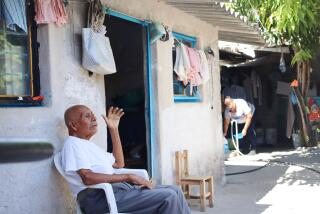The day started out sunny for a Texas balloon ride. Then clouds moved in, followed by tragedy
Before sunrise, meteorologists at the National Weather Service station in New Braunfels, Texas, peered into glowing monitors displaying weather models of the central Texas sky. It was early Saturday and conditions looked good, a pleasant 72 degrees with a light breeze.
In the rural darkness of nearby Kyle, Texas, Skip Nichols and Alan Lirette stood before the stone facade of their shared home, looked to the skies and smiled.
“Clear as you could want,” Lirette told Nichols, his roommate and the pilot of their shared operation, Heart of Texas Hot Air Balloon Rides. Nichols nodded.
It was 4 a.m.
In less than four hours, 16 people would be dead.
For men who relied on hot-air balloons to support themselves financially, wind was their engine and clouds their enemy. To look up and see low and overcast skies would mean cancellations, refunds and apologies. But this Saturday morning looked like a winner. There were 15 people scheduled to ride in their steel-framed wicker basket over San Marcos, Texas, with Nichols as their pilot.
“You could see every star in the sky,” Lirette told The Times.
An hour later, weather data showed a broken cloud ceiling forming at 1,100 feet. Balloonists are generally instructed to keep their craft at least 500 feet above inhabited areas, and a falling ceiling could spell trouble.
NEWSLETTER: Get the day’s top headlines from Times Editor Davan Maharaj >>
But the winds were calm. Nichols drove to the takeoff spot outside San Marcos, where the customers loaded into the hot-air balloon for takeoff. Just before sunrise, a few clouds formed in a low layer, 700 feet.
The sun rose at 6:50 a.m. Minutes later, the balloon took off.
Nichols navigated with an iPad, and stayed on the phone with ground crew in “chase cars” following the balloon.
Within minutes, the cloud ceiling began to solidify. A chilly mist blew in from the north and visibility dropped from 10 miles to 4 miles to 2.
The cloud ceiling dropped from 700 feet to 600 feet at 7:30 a.m. Ten minutes later, it was at 500 feet and dropping. The wind was calm but the humidity in the air was at 100%.
The cloud ceiling dropped to 300 feet, then 200.
A woman walking her dog on the outskirts of Lockhart heard a pop-pop-pop near a wheat field. At 7:42 a.m., a power line in the area recorded a failure. The woman turned and saw a fireball under the power lines.
It was the balloon. It had traveled 8 miles from its takeoff location, and when emergency responders reached the crash site, the basket carrying passengers was three-quarters of a mile from the balloon itself.
All 16 people aboard were killed, the worst such disaster in U.S. history.
Investigators have begun the grim job of sorting through the wreckage of the crashed balloon and are forced to rely solely on dental records to identify the bodies, a process that could take months, said Matt Kiely, a Caldwell County justice of the peace.
Distinguishing one person from another will be “a long process,” the National Transportation Safety Board said in a statement Sunday.
The NTSB will be looking for cellphone videos from those inside the balloon when it crashed and caught fire early Saturday, said NTSB member Robert Sumwalt at a news conference in Washington on Sunday.
“We look at three things: the human, the machine and the environment,” Sumwalt said. “What that means is we’re looking at the operation of the balloon, the pilot [and] the company that operated the balloon.”
Sumwalt refused to speculate Sunday on what led to the crash near this small, leafy central Texas town, which is on the edge of the Austin metro area and is known for its barbecue restaurants. Sumwalt said the NTSB had not yet located a passenger manifest.
Lirette, the surviving partner in the balloon business, said he had been told by the NTSB and the Federal Aviation Administration not to talk to reporters, but decided to speak because he wanted to clear his friend’s name before he was judged unfairly. He did not discuss what caused the crash, and ended the interview after less than two minutes.
The crash and ensuing fire took place near – or possibly under – high-capacity power lines. Aerial photos show charred earth directly beneath the power lines at the crash site.
The NTSB was eager to speak to the people in the chase cars, which typically pick up riders after they land.
“We think there may be some chase footage from those cars,” Sumwalt said.
The crash investigators also will be looking for “perishable evidence” from the scene, Sumwalt said. Such evidence includes physical remains, but also people’s memories of what they saw and heard, which investigators will try to record before too much time can pass.
Asked whether the atmospheric conditions could have contributed to the crash, Sumwalt said investigators were assessing that possibility.
“The weather report in the area showed a 500-foot ceiling. Not only the cloud cover, visibility and the winds, but we will also be looking at the temperature to see if the conditions might have created a density altitude,” he said.
A density altitude is an atmospheric condition in which hot, humid air creates low-air density, making it more difficult to achieve lift.
Warning about potential high-fatality accidents, safety investigators recommended two years ago that the FAA impose greater oversight on commercial hot-air balloon operators, government documents show.
The FAA rejected those recommendations, and the NTSB classified the FAA’s response to the balloon safety recommendations as “open-unacceptable,” which means the safety board was not satisfied with the FAA’s response.
Asked Sunday whether the crash would prompt a review of the recommendations, Sumwalt said the decision remains with the FAA.
Twitter: @nigelduara
ALSO
How to combat Asian carp? Get an alligator gar
Shooting in downtown Austin leaves 1 dead, 3 wounded; suspect sought
1 dead, 2 missing after historic Maryland town is ravaged by floodwaters
UPDATES:
6:25 p.m.: Updated with background on Lirette’s interview.
6 p.m.: The story was updated throughout with description, details and background.
The story was originally posted at 11:30 a.m.
More to Read
Start your day right
Sign up for Essential California for news, features and recommendations from the L.A. Times and beyond in your inbox six days a week.
You may occasionally receive promotional content from the Los Angeles Times.







